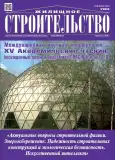Расчеты акустической эффективности шумозащитных экранов на основе численного решения уравнения дифракции звука
- Авторы: Антонов А.И.1,2, Гусев В.П.1, Леденев В.И.1,2, Матвеева И.В.2, Шубин И.Л.1
-
Учреждения:
- Научно-исследовательский институт строительной физики РААСН
- Тамбовский государственный технический университет
- Выпуск: № 6 (2024)
- Страницы: 10-15
- Раздел: СТАТЬИ
- URL: https://journals.eco-vector.com/0044-4472/article/view/634816
- DOI: https://doi.org/10.31659/0044-4472-2024-6-10-15
- ID: 634816
Цитировать
Полный текст
Аннотация
В настоящее время в городской застройке для защиты от транспортного шума, шума вентиляционного оборудования, устанавливаемого на крышах зданий, а также от других линейных и точечных источников шума широко применяются шумозащитные экраны-стенки. Для оценки акустической эффективности таких экранов на стадии их проектирования используется практический метод расчета, предложенный З. Маекава для полубесконечных экранов простой геометрической формы. В то же время в практике снижения шума экранированием достаточно широкое применение находят экраны и других сложных геометрических форм при отсутствии и наличии в них различных технологических проемов и отверстий. В этом случае применение предложенного З. Маекавой метода расчета может давать существенные погрешности в оценке акустической эффективности экранирования. Для подобных случаев в статье предлагается использовать метод, основанный на численном решении уравнения дифракции звука. Разработана компьютерная программа для численного решения уравнения Френеля–Киргхофа и на ее основе показана возможность решения практических задач; оценено влияние проемов и зазоров, имеющихся в экранах конечных размеров, на акустическую эффективность экранирования. Предложенный численный метод может применяться на стадии проектирования сложных по форме плоских шумозащитных экранов.
Полный текст
Об авторах
А. И. Антонов
Научно-исследовательский институт строительной физики РААСН; Тамбовский государственный технический университет
Автор, ответственный за переписку.
Email: aiant58@yandex.ru
д-р техн. наук
Россия, 127238, г. Москва, Локомотивный пр., 21; 392000, г. Тамбов, ул. Советская, 106В. П. Гусев
Научно-исследовательский институт строительной физики РААСН
Email: niisf@mail.ru
д-р техн. наук
Россия, 127238, г. Москва, Локомотивный пр., 21В. И. Леденев
Научно-исследовательский институт строительной физики РААСН; Тамбовский государственный технический университет
Email: ledvi46@yandex.ru
д-р техн. наук
Россия, 127238, г. Москва, Локомотивный пр., 21; 392000, г. Тамбов, ул. Советская, 106И. В. Матвеева
Тамбовский государственный технический университет
Email: times02@yandex.ru
канд. техн. наук
Россия, 392000, г. Тамбов, ул. Советская, 106И. Л. Шубин
Научно-исследовательский институт строительной физики РААСН
Email: niisf@niisf.ru
чл.-корр. РААСН, д-р техн. наук
Россия, 127238, г. Москва, Локомотивный пр., 21Список литературы
- Иванов Н.И., Светлов В.В., Шашурин А.Е. Снижение шума стационарных источников в жилой застройке технологическими шумозащитными экранами // Безопасность жизнедеятельности. 2018. № 6 (210). С. 16–22.
- Тюрина Н.В. Применение акустических экранов для снижения шума в городской застройке. Защита населения от повышенного шумового воздействия: Сборник докладов V Всероссийской научно-практической конференции с международным участием. СПб., 2015. С. 97–112.
- Шубин И.Л., Гребенкин А.М., Гребенкина Е.В. Принципы проектирования шумозащитных сооружений в городской среде // Строительство и реконструкция. 2017. № 3 (71). С. 101–106.
- Maekava Z. Recent Problems with Noise Barriers. Noise-93 Conference. St. Petersburg, Russia. 1993, pp. 125–131.
- Maekawa Z. Environmental acoustics update // Journal of the Acoustical Society of Japan (E). 1997. Vol. 18,3, pp. 97–107.
- Maekava Z. Noise Reduction by screens // Applied Acoustics. 1968. Vol. 1, pp. 157–173.
- Борн М., Вольф Э. Основы оптики. М.: Наука, 1973. 720 с.
- Kurze U.J. Noise reduction by barriers // J.A.S.A. 1974. Vol. 55. No. 3, pp. 504–518.
- Маекава З. Акустические экраны. В кн.: Снижение шума в зданиях и жилых районах / Под ред. Г.Л. Осипова, Е.Я. Юдина. М.: Стройиздат, 1987. С. 426–448.
- Кузминова С.А., Тупов В.Б. Влияние технологических проемов на акустическую эффективность экранов газорегуляторного пункта // Вестник Московского энергетического института. 2020. № 3. С. 81–88.
- Чувирова С.А., Тупов В.Б. Возможности акустических экранов для снижения шума ГРП и газопроводов после него. Защита от повышенного шума и вибраций: Сборник докладов VII Всероссийской научно-практической конференции с международным участием. СПб., 2019. С. 726–732.
- Тупов В.Б. Особенности использования экранов для снижения шума энергетического оборудования. Защита от повышенного шума и вибраций: Сборник докладов VIII Всероссийской научно-практической конференции с международным участием. СПб., 2021. С. 20–27.
- Тюрина Н.В., Минина Н.Н. Снижение шума акустическими экранами, установленными на эстакадах // Безопасность жизнедеятельности. 2012. № 6. С. 26–27.
- Гусев В.П., Леденев В.И., Шубин И.Л. Оптимальная защита окружающей среды от шумового воздействия оборудования систем ОВК // Биосферная совместимость: человек, регион, технологии. 2014. № 3 (7). С. 32–42.
Дополнительные файлы














